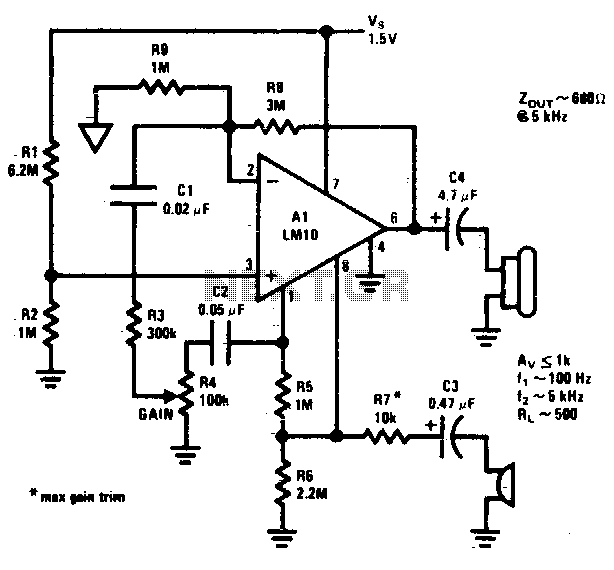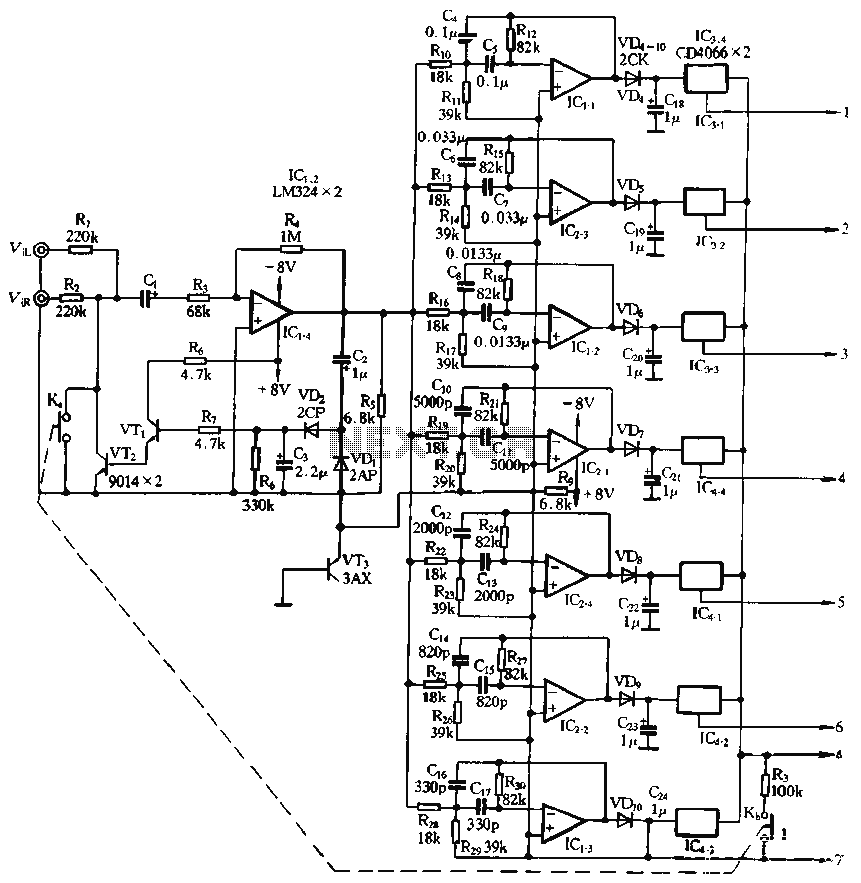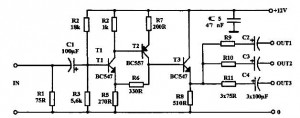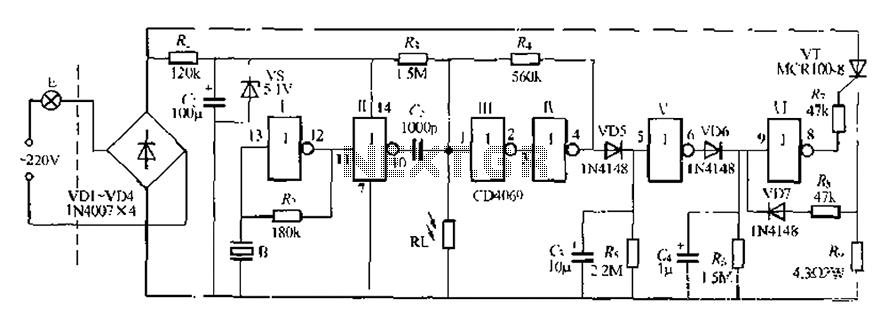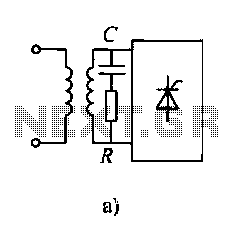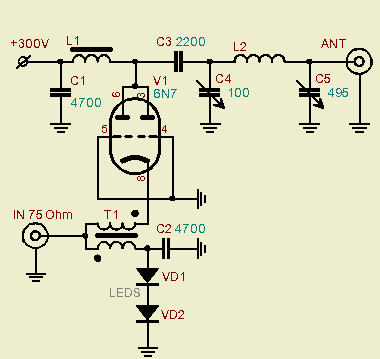
150 watt amplifier circuit
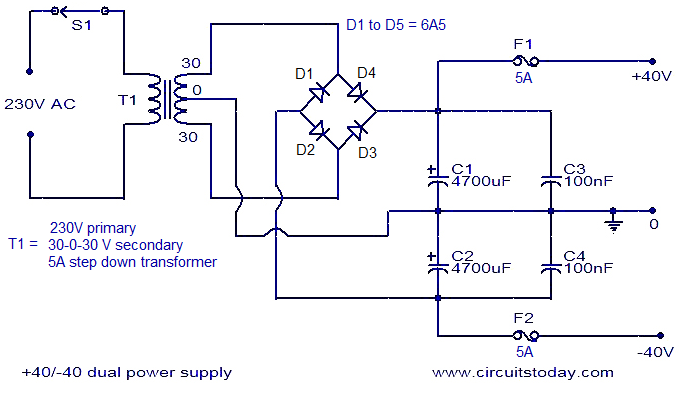
This is an economical 150 Watt amplifier circuit that utilizes two complementary Darlington power transistors, TIP 142 and TIP 147. It is capable of delivering a robust 150 W RMS to a 4 Ohm speaker, offering significant audio output. The TIP 147 and TIP 142 transistors can handle a current of 5 A and a voltage of 100V, making them well-known for their durability. The circuit incorporates two BC 558 transistors (Q5 and Q6) configured as a preamplifier, while the TIP 142, TIP 147, and TIP42 (Q1, Q2, Q3) are responsible for driving the speaker. This design is sufficiently rugged to be assembled on a perf board or through pin-to-pin soldering. The circuit requires a +/-45V 5A dual power supply. The preamplifier section consists of Q4 and Q5, which form a differential amplifier that minimizes noise and allows for negative feedback, thus enhancing the overall performance of the amplifier. The input signal is fed to the base of Q5 via a DC decoupling capacitor (C2), while feedback voltage is applied to the base of Q4 from the junction of two 0.33-ohm resistors through a 22K resistor. A complementary Class AB push-pull stage is constructed around transistors Q1 and Q2 to drive the loudspeaker, with diodes D1 and D2 providing biasing to ensure Class AB operation. Transistor Q3 drives the push-pull pair, with its base directly coupled to the collector of Q5. It is important to note that TIP 142 and TIP 147 are Darlington pairs, represented as conventional transistors in the schematic for simplicity. Each Darlington pair consists of two transistors, two resistors, and one diode internally, but they are treated as standard transistors with three terminals: base, emitter, and collector. A +40/-40 unregulated dual supply is recommended for this amplifier project, sufficient for powering one channel; for stereo applications, the current ratings of the transformer, diodes, and fuses should be doubled.
The amplifier circuit is designed to deliver high-quality audio performance while maintaining simplicity and ease of assembly. The use of Darlington pairs provides high current gain, which is beneficial in achieving the desired power output without requiring complex circuitry. The differential amplifier configuration in the preamplifier stage plays a crucial role in reducing unwanted noise and improving the signal-to-noise ratio, which is essential for high-fidelity audio applications.
The circuit's layout can be implemented on a perf board, allowing for flexibility in component placement and ease of troubleshooting. The choice of components, such as the BC 558 transistors for the preamplifier and the robust TIP transistors for the output stage, ensures reliability and longevity in operation. The overall design philosophy focuses on achieving a balance between performance and simplicity, making it an ideal choice for hobbyists and audio enthusiasts looking to build a powerful amplifier on a budget.
When constructing the power supply, it is important to ensure that the transformer can handle the required load current, especially in stereo applications, where doubled ratings are necessary. Additionally, proper heat sinking for the TIP transistors should be considered to prevent thermal runaway and ensure stable operation under load. The design allows for customization and experimentation, making it a valuable project for those interested in audio electronics.This is the cheapest 150 Watt amplifier circuit you can get, I think. Based on two Darlington power transistors TIP 142 and TIP 147, this circuit can deliver a blasting 150 W Rms to a 4 Ohm speaker. Enough for you to get rocked, then try out this. TIP 147 and 142 are complementary Darlington pair transistors which can handle 5 A current and 100V, fam
ous for their ruggedness. Here two BC 558 transistorsQ5 and Q6 are wired as pre amplifier and TIP 142, TIP 147 together with TIP42 (Q1, Q2, Q3) for driving the speaker. This circuit is designed so rugged that this can be assembled even on a perf board or even by pin to pin soldering.
The circuit can be powered from a +/-45V 5A dual power supply. You must try this circuit. Its working great. The preamplifier section of this circuit is based around Q4 and Q5 which forms a differential amplifier. The use of a differential amplifier in the input stage reduces noise and also provides a means for applying negative feedback.
Thus overall performance of the amplifier is improved. Input signal is applied to the base of Q5 through the DC decoupling capacitor C2. Feedback voltage is applied to the base of Q4 from the junction of 0. 33 ohm resistors through the 22K resistor. A complementary Class AB push-pull stage is built around the transistors Q1 and Q2 for driving the loud speaker. Diodes D1 and D2 biases the complementary pair and ensures Class AB operation. Transistor Q3 drives the push-pull pair and its base is directly coupled to the collector of Q5. Remember TIP 142 and 147 are Darlington pairs. They are shown as conventional transistors in figure for ease. So don`t get confused. Even though each of them have 2 transistors, 2 resistors and 1 diode inside, only three pins, base emitter and collector are coming out.
Rest are connected internally. So its quite OK to assume each of them as transistor for ease. A +40/-40 unregulated dual supply for powering this amplifier project is shown below. This power supply is only enough for powering one channel and for stereo applications double the current ratings of the transformer, diodes and fuses. 🔗 External reference
The amplifier circuit is designed to deliver high-quality audio performance while maintaining simplicity and ease of assembly. The use of Darlington pairs provides high current gain, which is beneficial in achieving the desired power output without requiring complex circuitry. The differential amplifier configuration in the preamplifier stage plays a crucial role in reducing unwanted noise and improving the signal-to-noise ratio, which is essential for high-fidelity audio applications.
The circuit's layout can be implemented on a perf board, allowing for flexibility in component placement and ease of troubleshooting. The choice of components, such as the BC 558 transistors for the preamplifier and the robust TIP transistors for the output stage, ensures reliability and longevity in operation. The overall design philosophy focuses on achieving a balance between performance and simplicity, making it an ideal choice for hobbyists and audio enthusiasts looking to build a powerful amplifier on a budget.
When constructing the power supply, it is important to ensure that the transformer can handle the required load current, especially in stereo applications, where doubled ratings are necessary. Additionally, proper heat sinking for the TIP transistors should be considered to prevent thermal runaway and ensure stable operation under load. The design allows for customization and experimentation, making it a valuable project for those interested in audio electronics.This is the cheapest 150 Watt amplifier circuit you can get, I think. Based on two Darlington power transistors TIP 142 and TIP 147, this circuit can deliver a blasting 150 W Rms to a 4 Ohm speaker. Enough for you to get rocked, then try out this. TIP 147 and 142 are complementary Darlington pair transistors which can handle 5 A current and 100V, fam
ous for their ruggedness. Here two BC 558 transistorsQ5 and Q6 are wired as pre amplifier and TIP 142, TIP 147 together with TIP42 (Q1, Q2, Q3) for driving the speaker. This circuit is designed so rugged that this can be assembled even on a perf board or even by pin to pin soldering.
The circuit can be powered from a +/-45V 5A dual power supply. You must try this circuit. Its working great. The preamplifier section of this circuit is based around Q4 and Q5 which forms a differential amplifier. The use of a differential amplifier in the input stage reduces noise and also provides a means for applying negative feedback.
Thus overall performance of the amplifier is improved. Input signal is applied to the base of Q5 through the DC decoupling capacitor C2. Feedback voltage is applied to the base of Q4 from the junction of 0. 33 ohm resistors through the 22K resistor. A complementary Class AB push-pull stage is built around the transistors Q1 and Q2 for driving the loud speaker. Diodes D1 and D2 biases the complementary pair and ensures Class AB operation. Transistor Q3 drives the push-pull pair and its base is directly coupled to the collector of Q5. Remember TIP 142 and 147 are Darlington pairs. They are shown as conventional transistors in figure for ease. So don`t get confused. Even though each of them have 2 transistors, 2 resistors and 1 diode inside, only three pins, base emitter and collector are coming out.
Rest are connected internally. So its quite OK to assume each of them as transistor for ease. A +40/-40 unregulated dual supply for powering this amplifier project is shown below. This power supply is only enough for powering one channel and for stereo applications double the current ratings of the transformer, diodes and fuses. 🔗 External reference
